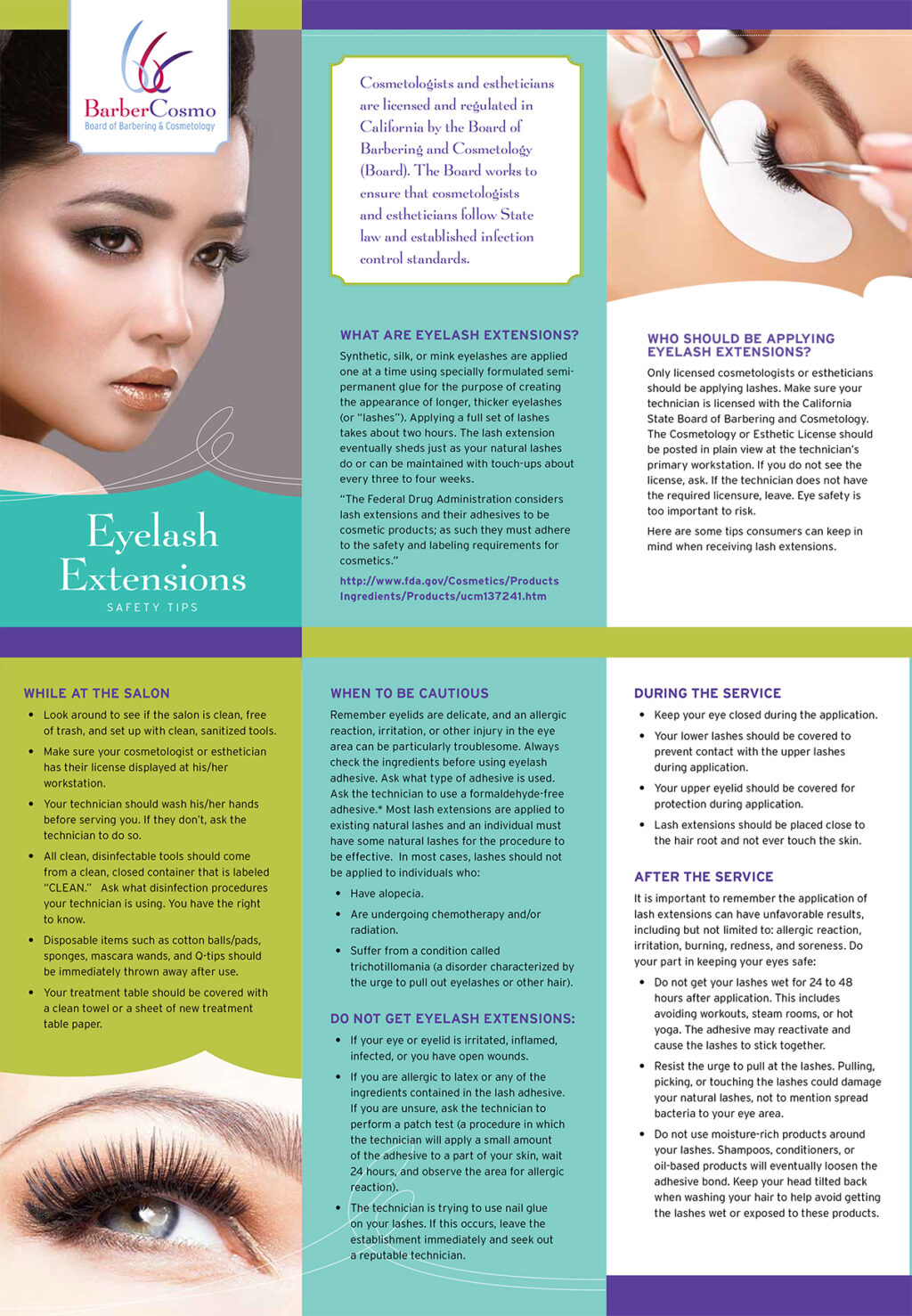Cosmetologists and estheticians are licensed and regulated in California by the Board of Barbering and Cosmetology (#BarberCosmo). The Board works to ensure that cosmetologists and estheticians follow State law and established infection control standards.
WHAT ARE #EYELASHEXTENSIONS?
Synthetic, silk or mink eyelashes are applied one at a time using specially formulated semi-permanent glue to create the appearance of longer, thicker #eyelashes (or “#lashes”). Applying a full set of lashes takes about two hours. The #lashextension eventually sheds just as your natural lashes do or can be maintained with touch-ups about every three to four weeks.
The Federal Drug Administration considers lash extensions and their adhesives to be cosmetic products; as such, they must adhere to cosmetics safety and labeling requirements.
WHO SHOULD BE APPLYING EYELASH EXTENSIONS?
Only licensed cosmetologists or estheticians should be applying lashes. Make sure your technician is licensed with the California State Board of Barbering and Cosmetology. The Cosmetology or Esthetic License should be posted in plain view at the technician’s primary workstation.
If you do not see the license, ask. If the technician does not have the required licensure, leave. Eye safety is too important to risk.

Here are some tips consumers can keep in mind when receiving lash extensions.
WHILE AT THE SALON
- Look around to see if the lash or beauty salon is free of hazards, clean, hygienic, and set up with sanitized tools.
- Make sure your cosmetologist or esthetician has their license displayed at their workstation.
- Your technician should wash their hands before serving you. If they don’t, ask the technician to do so.
- All clean, disinfectable tools should come from a clean, closed container that is labeled “Clean.” ask what disinfection procedures your technician is using. You have the right to know.
- Disposable items such as cotton balls/pads, sponges, mascara wands, and Q-tips should be immediately thrown away after use.
- Your treatment table should be covered with a clean towel or a sheet of new treatment table paper.
WHEN TO BE CAUTIOUS
Remember eyelids are delicate, and an allergic reaction, irritation, or another eye injury can be particularly troublesome. Always check the ingredients before using eyelash adhesive. Ask what type of adhesive is used. ask the technician to use a formaldehyde-free adhesive.*
Most lash extensions are applied to existing natural lashes, and an individual must have some natural lashes for the procedure to be effective. in most cases, lashes should not be applied to individuals who:
- Have alopecia.
- Are undergoing chemotherapy and/or radiation.
- Suffer from a condition called trichotillomania (a disorder characterized by the urge to pull out eyelashes or other hair).
DO NOT GET EYELASH EXTENSIONS:
- If your eye or eyelid is irritated, inflamed, infected, or you have open wounds.
- If you are allergic to latex or any of the ingredients contained in the lash adhesive. If you are unsure, ask the technician to perform a patch test (a procedure in which the technician will apply a small amount of the glue to a part of your skin, wait 24 hours, and observe the area for allergic reaction).
- The technician is trying to use nail glue on your lashes. If this occurs, leave the establishment immediately and seek a reputable technician.
DURING THE SERVICE
- Keep your eye closed during the application.
- Your lower lashes should be covered to prevent contact with the upper lashes during application.
- Your upper eyelid should be covered for protection during application.
- Lash extensions should be placed close to the hair root and not ever touch the skin.
AFTER THE SERVICE
- It is important to remember the application of lash extensions can have unfavorable results, including but not limited to: allergic reactions, irritation, burning, redness, and soreness. Do your part in keeping your eyes safe:
- Do not get your lashes wet for 24 to 48 hours after application. This includes avoiding workouts, steam rooms, or hot yoga. The adhesive may reactivate and cause the lashes to stick together.
- Resist the urge to pull at the lashes. Pulling, picking, or touching the lashes could damage your natural lashes, not to mention spread bacteria to your eye area.
- Do not use moisture-rich products around your lashes. Shampoos, conditioners, or oil-based products will eventually loosen the adhesive bond. Keep your head tilted back when washing your hair to help avoid getting the lashes wet or exposed to these products.

